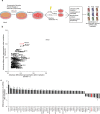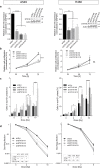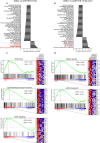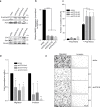Syntaxin 18 regulates the DNA damage response and epithelial-to-mesenchymal transition to promote radiation resistance of lung cancer
- PMID: 35668077
- PMCID: PMC9170725
- DOI: 10.1038/s41419-022-04978-4
Syntaxin 18 regulates the DNA damage response and epithelial-to-mesenchymal transition to promote radiation resistance of lung cancer
Abstract
Radiotherapy is an important modality in lung cancer treatment. Despite advances in treatment planning and dose delivery, patient benefit is still limited by in-field relapse and metastatic recurrence. Simultaneous application of cisplatinum-based chemotherapy leads to moderately improved outcomes, thus providing proof-of-concept for radiosensitization strategies in lung cancer. In an unbiased functional genetic screen for radiosensitization targets in lung cancer, we identified syntaxin 18, a protein involved in retrograde vesicular transport between the Golgi apparatus and endoplasmic reticulum, as mediator of radioresistance. Downregulation of endogenous syntaxin 18 specifically reduced clonogenic survival of radioresistant and radiosensitive lung cancer cells following X-radiation. Gene expression programs regulating DNA repair, mitotic checkpoints and mitosis were altered in isogenic cells with reduced syntaxin 18 expression. Functionally, this translated into impaired DNA damage-induced cell cycle checkpoints leading to cell death by mitotic catastrophe. Interestingly, downregulation of syntaxin 18 in lung cancer cells also impaired expression of markers of epithelial-mesenchymal-transition, and reduced migration and invasion capacity. These findings suggest that syntaxin 18 is a key player regulating genes responsible for controlling the growth of the primary tumor as well as metastases upon radiotherapy of lung cancer. They provide a promising lead for biologically rational radiosensitization strategies impacting on radiation-induced cell death as well as metastasis.
© 2022. The Author(s).
Conflict of interest statement
The authors declare no competing interests.
Figures





Similar articles
-
Tumor suppressor miR-29c regulates radioresistance in lung cancer cells.Tumour Biol. 2017 Mar;39(3):1010428317695010. doi: 10.1177/1010428317695010. Tumour Biol. 2017. PMID: 28345453
-
Mechanisms of different response to ionizing irradiation in isogenic head and neck cancer cell lines.Radiat Oncol. 2019 Nov 27;14(1):214. doi: 10.1186/s13014-019-1418-6. Radiat Oncol. 2019. PMID: 31775835 Free PMC article.
-
ITGB1 enhances the Radioresistance of human Non-small Cell Lung Cancer Cells by modulating the DNA damage response and YAP1-induced Epithelial-mesenchymal Transition.Int J Biol Sci. 2021 Jan 18;17(2):635-650. doi: 10.7150/ijbs.52319. eCollection 2021. Int J Biol Sci. 2021. PMID: 33613118 Free PMC article.
-
The Molecular and Cellular Strategies of Glioblastoma and Non-Small-Cell Lung Cancer Cells Conferring Radioresistance.Int J Mol Sci. 2022 Nov 5;23(21):13577. doi: 10.3390/ijms232113577. Int J Mol Sci. 2022. PMID: 36362359 Free PMC article. Review.
-
Cellular Pathways in Response to Ionizing Radiation and Their Targetability for Tumor Radiosensitization.Int J Mol Sci. 2016 Jan 14;17(1):102. doi: 10.3390/ijms17010102. Int J Mol Sci. 2016. PMID: 26784176 Free PMC article. Review.
Cited by
-
Blood-based biomarkers derived from tumor-informed DNA methylation analysis for lung adenocarcinoma.Heliyon. 2025 Feb 11;11(4):e42581. doi: 10.1016/j.heliyon.2025.e42581. eCollection 2025 Feb 28. Heliyon. 2025. PMID: 40034277 Free PMC article.
-
Targeting DNA Damage Response-Mediated Resistance in Non-Small Cell Lung Cancer: From Mechanistic Insights to Drug Development.Curr Oncol. 2025 Jun 23;32(7):367. doi: 10.3390/curroncol32070367. Curr Oncol. 2025. PMID: 40710178 Free PMC article. Review.
-
Overexpression of ESYT3 improves radioimmune responses through activating cGAS-STING pathway in lung adenocarcinoma.Exp Hematol Oncol. 2024 Aug 5;13(1):77. doi: 10.1186/s40164-024-00546-y. Exp Hematol Oncol. 2024. PMID: 39103908 Free PMC article.
-
Ferroptosis, Metabolic Rewiring, and Endometrial Cancer.Int J Mol Sci. 2023 Dec 20;25(1):75. doi: 10.3390/ijms25010075. Int J Mol Sci. 2023. PMID: 38203246 Free PMC article. Review.
-
Preparation of Multifunctional Nano-Protectants for High-Efficiency Green Control of Anthracnose.Adv Sci (Weinh). 2024 Dec;11(48):e2410585. doi: 10.1002/advs.202410585. Epub 2024 Nov 18. Adv Sci (Weinh). 2024. PMID: 39556712 Free PMC article.
References
Publication types
MeSH terms
Substances
LinkOut - more resources
Full Text Sources
Medical

